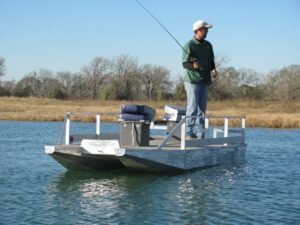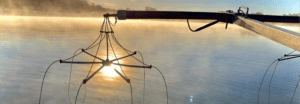Fishery tips: Prepping your fishing lake for a great season
By Lochow Ranch
Fishery management experts know that year-round pond and lake maintenance is key to keeping your favorite fishing pond healthy and productive.
The leading reasons the equilibrium in your lake could be off include over- and under-harvesting of predator fish, introduction of undesirable fish species, and summer kills, as well as excessive weeds, poor water quality and lack of fertilization.
Qualified experts like those at Lochow Ranch Pond & Lake Management can help turn around a failing fishery or enhance a stable one by addressing these various issues in an annual plan that tracks progress and addresses needs.
Otherwise, Texas A&M AgriLife Extension Service warns that Texas farm ponds aren’t managed at their highest potential for fish production.
Lochow Ranch can assess fishery populations using nets or shocking equipment and use state-of-the-art equipment to collect data and determine the precise program for getting your body of water back on track.
Surveying Your Pond’s Population

An excellent way to begin is with an electrofishing survey, which is a primary tool for correcting an out-of-balance pond.
These surveys accurately assess current forage and sport fish populations and quantify wintertime Cormorant or otter damage. Fish populations also are sampled to determine species, size, relative abundance and growth rates. Click here to learn more.
Planning Pond Stocking

Pond stocking is another important consideration when you want to maximize the potential for your fishery.
What kinds of fish will work best in your pond involves many variables, including your own goals for your pond or lake. For example, you need to carefully assess the impact of introducing non-native species into your pond. It’s important to be aware of the fish types that can live together in harmony so your pond can sustain a healthy ecosystem. Learn more by clicking here.
Getting a grip on pond weeds
Aquatic vegetation is the cause of 80 percent of low dissolved oxygen fish kills in Texas. And the issues are complex enough that expert advice is recommended.
 As we detailed in a series of recent postings about pond vegetation control, there are a range of vegetation control techniques. Mechanical controls include pruning and cutting back pond weeds. Biological controls include introducing grass carp and tilapia, two types of vegetation-eating fish. Chemical means of vegetation control include herbicides and algaecides.
As we detailed in a series of recent postings about pond vegetation control, there are a range of vegetation control techniques. Mechanical controls include pruning and cutting back pond weeds. Biological controls include introducing grass carp and tilapia, two types of vegetation-eating fish. Chemical means of vegetation control include herbicides and algaecides.
Fertilizing your fishery
Just as you would fertilize fields to increase crop yields, you should fertilize a pond or lake to provide phytoplankton with adequate nutrients for fish growth.
Proper fertilization increases food availability throughout the food chain and indirectly increases the total amount of fish a pond can support. Ponds should be limed before fertilizer is applied, which is important because it increases pH and alkalinity.
Even without fertilization, this may improve available nutrients which can support a phytoplankton bloom. Click here to learn more.
Adding aeration
In order to avoid problems, pond and lake owners also should be inspecting aeration and fountain maintenance or considering their implementation.
 Repairs could address obvious signs of wear or just the cleaning of filters and screens. Lochow offers a range of aeration systems and fountain systems for ensuring your pond’s oxygen levels are optimal.
Repairs could address obvious signs of wear or just the cleaning of filters and screens. Lochow offers a range of aeration systems and fountain systems for ensuring your pond’s oxygen levels are optimal.
Plan for a great year
Our team of fishery management experts are standing by to help you make the most of your fishing pond. Whether you are looking for pond water testing, pond stocking, fishery management, pond renovation or new pond construction, we can help. A great lake can be a legacy that will be enjoyed by friends and family for generations to come. Fill out the form to get started today!
Why Choose Lochow Ranch for Pond & Lake Management
Serving Texas, Oklahoma, Arkansas and Louisiana, Lochow Ranch Pond & Lake Management proudly puts more than two decades of experience to work for you. Our team includes biologists, technicians and other professionals with deep expertise in pond and lake management services.
Check us out if you are considering building a lake, looking for pond stocking services, to buy fish for a pond, or getting professional pond management and maintenance or fishery management. Our services include lake design, pond construction, pond renovation, pond water testing, electrofishing, pond stocking, control of pond weeds, and pond liming and fertilizing. Let us help you build your dream pond that will delight your family and friends for generations to come.


 Be sure to conduct the necessary annual harvest of predatory fish to ensure that forage populations thrive. It goes without saying that no fishery can sustainably support predation from huge flocks of avian predators without some supplemental stocking from time to time.
Be sure to conduct the necessary annual harvest of predatory fish to ensure that forage populations thrive. It goes without saying that no fishery can sustainably support predation from huge flocks of avian predators without some supplemental stocking from time to time.




Recent Comments